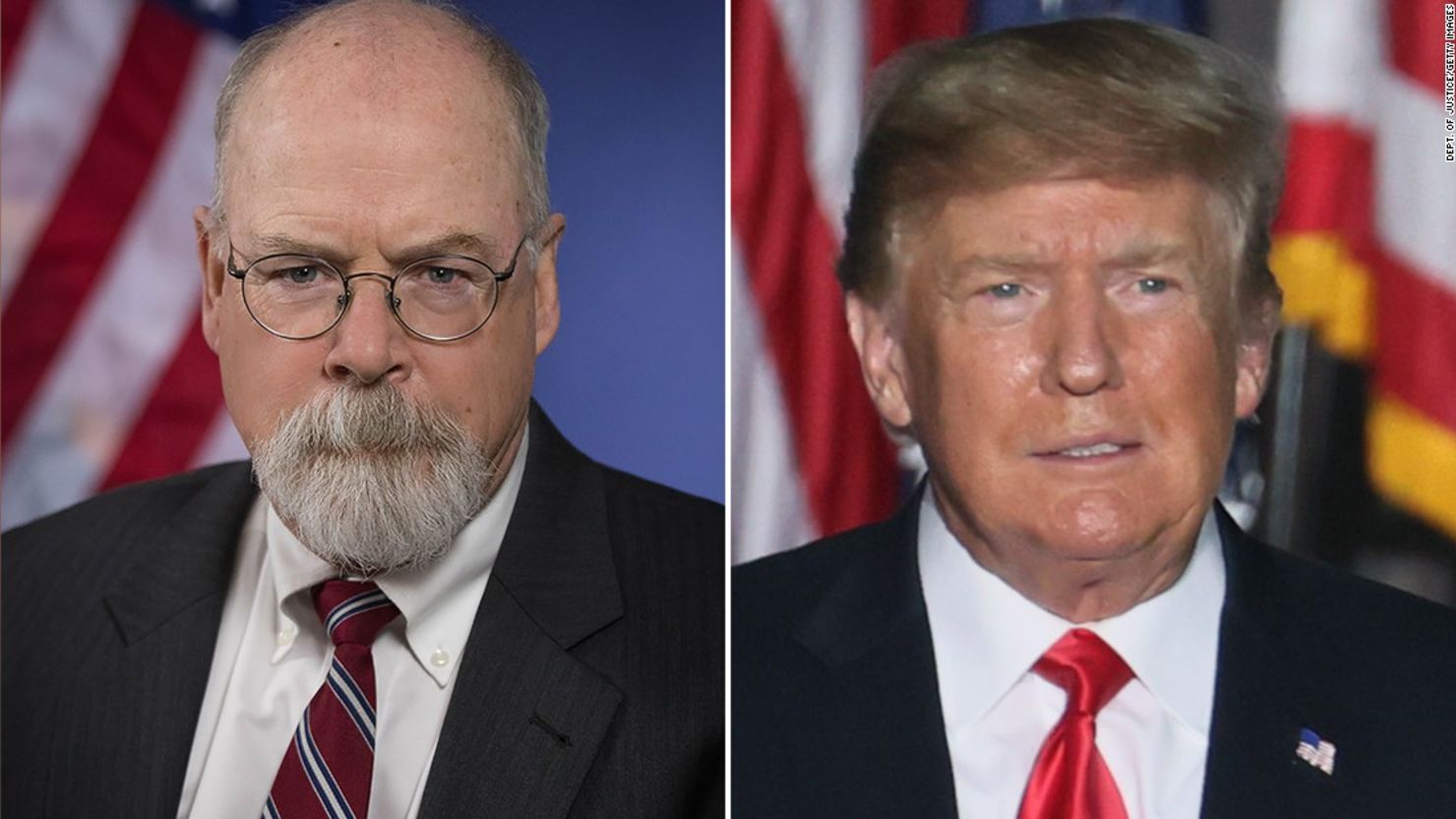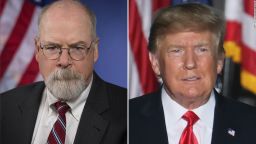Special counsel John Durham, who has been investigating the origins of the FBI’s Trump-Russia probe, ignited a firestorm in right-wing circles last weekend with a cryptic court filing.
The new filing fleshed out the case against Michael Sussmann, a lawyer for Hillary Clinton’s 2016 presidential campaign who was charged with lying to a top FBI official during a meeting about then-candidate Donald Trump’s connections to Russia. In the filing, Durham suggested Sussmann’s allies “exploited” government databases to snoop on the Trump White House.
This triggered a tsunami of coverage from pro-Trump outlets, and outrage from Republican lawmakers and Trump himself – all of it rife with distortions, false claims and misinformation.
In a rebuttal filing Monday, Sussmann’s lawyers said Durham was wrong about critical facts. His lawyers say the data was properly obtained and predated Trump’s presidency. They also accused Durham of deliberately ginning up a false narrative for right-wing media.
Cyber researchers involved have said they are apolitical actors who were concerned about the national security implications of the data they uncovered. They also say Durham is cherry-picking their emails to make it look like they fabricated an unfounded narrative about Trump and Russia.
Here’s a full breakdown of the latest twists and turns, in a saga that started over five years ago.
What new material did Durham reveal?
Durham previously accused Sussmann of working with cybersecurity researchers and data scientists to undermine Trump in 2016. They allegedly did this by digging up dirt about his ties to Russia, and peddling it to the media and US government agencies, in hopes of triggering an investigation. (Sussmann, who was charged with lying to a top FBI official, has pleaded not guilty and the case is slated to go to trial later this year.)
Durham alleged these researchers examined “domain name system” data, often called DNS lookups. It’s like looking for a number in the phone book. A log is created when a computer gets ready to connect with a server, but the lookup itself doesn’t prove that any communication occurred. Durham claims the cyber researchers had access to this trove of DNS data through a federal government contract.

Sussmann’s allies believed they found some potentially alarming links from Trump to Russia, and have said it was within the purview of their government contract to look for security threats.
One dataset possibly linked the Trump Organization to Alfa Bank, the largest private bank in Moscow. Separate DNS lookups suggested that obscure Russian-made smartphones may have been used at Trump Tower and the White House. Durham’s recent filings gave the impression that this data was from during Trump’s presidency, but that assertion is now hotly contested.
What did Sussmann do with the data?
Durham previously revealed that Sussmann met with a top FBI official in September 2016 and passed along the information about the potential Trump-Alfa connections. Sussmann also met with CIA officials in February 2017, and Durham’s latest filing gave new insights into what was discussed.
During that meeting with CIA officials, Sussmann “further claimed that these (DNS) lookups demonstrated that Trump and/or his associates were using supposedly rare, Russian-made wireless phones in the vicinity of the White House and other location,” Durham said in the filing.

But Sussmann’s lawyers claim that isn’t what he told the CIA – and that Durham knows it. They also highlighted the fact that the meeting occurred after Trump took office, and therefore couldn’t have been an attempt to undermine his campaign.
“The Special Counsel is well aware that the data provided to (the CIA) pertained only to the period of time before Mr. Trump took office, when Barack Obama was President,” they wrote in their court filing, accusing Durham of intentionally crafting a misleading narrative.
What have Trump and his allies said?
Trump and his allies essentially have taken Durham’s assertions at face value – and then some. They claimed, falsely, that the filings prove Trump was the victim of a massive deep state conspiracy to spy on his campaign and White House. Incredibly, Trump suggested that people involved deserve to be executed for their alleged actions.
In lie-filled press releases, Trump falsely said Durham revealed “indisputable evidence that my campaign and presidency were spied on.” Former Pentagon official Kash Patel, a Trump loyalist, falsely claimed that Durham had proven that Clinton’s campaign “directly funded and ordered its lawyers at Perkins Coie to orchestrate … a criminal enterprise to fabricate a connection between President Trump and Russia.”
Covering the Durham filings, Fox Business host Maria Bartiromo said the Clinton campaign paid to spy on Trump, “before and during his time as president,” even though Durham has never accused anyone of surveilling Trump’s calls. She was one of many Fox hosts and guests to exaggerate or distort Durham’s new filings.
In Sussmann’s view, the right-wing feeding frenzy was no accident. His lawyers said in a rebuttal that “the Special Counsel seems to be succeeding in his effort to instigate unfair and prejudicial media coverage,” citing articles from conservative outlets like the New York Post and Breitbart.
Was the Trump-Russia data accurate?
With regards to the alleged contacts between the Trump Organization and Alfa Bank, both companies denied that there was a backchannel or that they colluded on the 2016 election.
The FBI investigated the underlying data and ruled out any improper cyber links, according to the Justice Department inspector general. A bipartisan Senate Intelligence Committee report said in 2020 that it accepted the FBI’s conclusions, but the report also pointed out that the Trump Organization and Alfa Bank gave contradictory explanations for the “unusual activity.”
Regarding the Russian phones, Durham said his team “identified no support” for the claim that Trump associates used the devices near the White House. But Sussmann and the researchers called this a red herring. They said they found odd data at Trump Tower – and separately at the Obama-era White House, while looking for security threats after a Russian hack in 2015.
What comes next in this saga?
Legal experts have questioned the strength of Durham’s case against Sussmann. For instance, there is only one witness to the lie he allegedly told the FBI, and that witness has given differing accounts of the situation. Before his trial, Sussmann will try to convince a judge to throw out the case because there isn’t enough evidence. His first arguments on this front are due on Friday.
The five-year statute of limitations appears to have passed for Durham to charge Sussmann with crimes related to his CIA meeting. Sussmann maintains that he had no reason to doubt the information that he passed along to the CIA. Beyond that, the Durham inquiry is ongoing, but it’s unclear if he if has the goods to indict anyone else or allege a broader anti-Trump conspiracy.
Ironically, many of the key players have seen a role reversal in this saga.
There was rampant speculation in left-wing circles that special counsel Robert Mueller would bring down Trump’s presidency, and send him and his family to prison. Now, Trump and his allies are breathlessly hyping up the Durham probe, and have welcomed each development as proof that bombshell indictments against top Democratic figures are right around the corner.
CORRECTION: An earlier version of this story misstated which year the Senate report came out.
CNN’s Katelyn Polantz and Evan Perez contributed to this report.


